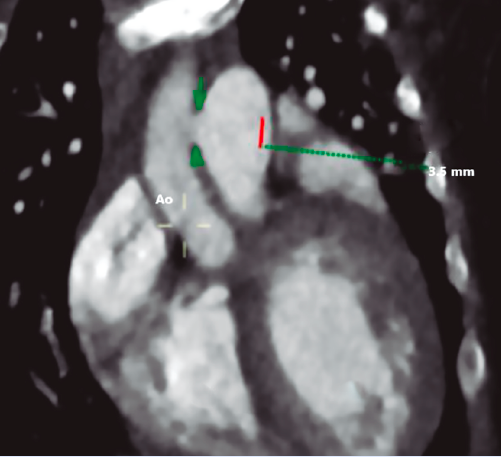Percutaneous aortopulmonary window closure using muscular ventricular septal defect occluder. Instituto Nacional de Salud del Niño San Borja Lima- Perú. Case Report
DOI:
https://doi.org/10.47487/apcyccv.v6i2.465Keywords:
Heart Defects Congenital, Aortopulmonary Septal Defect, Septal Occluder Device, Cardiac Catheterization, Doppler EchocardiographyAbstract
The aortopulmonary window is a rare congenital heart defect, and the aortopulmonary window without other associated defects represents up to 25% of these defects. Surgical closure has been and is the gold standard in many cardiovascular centers. However, percutaneous closure is being performed with different types of occluders, considering the type of defect, size, and edges in order to avoid complications such as valvular or coronary ostial involvement. We present the case of an infant with an aortopulmonary window who underwent percutaneous closure with a muscular ventricular septal defect occluder device without complications and was discharged 48 hours after the procedure.
Downloads
References
Sevinç Şengül F, Arslan P, Ayyıldız P, Öztürk E, Tanıdır İC, Yıldız O, et al. Aortopulmonary window: Classification, associated cardiac anomalies, treatment options, and clinical outcome. Cam and Sakura Med J. 2023;3(2):46–52. Doi: 10.4274/csmedj.galenos.2023.2023-5-1.
Barnes ME, Mitchell ME, Tweddell JS. Aortopulmonary window. Semin Thorac Cardiovasc Surg Pediatr Card Surg Annu. 2011 ;14(1) :67–74. doi: 10.1053/j.pcsu.2011.01.017.
Bhalgat P, Kulkarni D, Lovhale P. Tetralogy of Fallot and aortopulmonary window: Diagnosis and management. IHJ Cardiovasc Case Rep (CVCR) 2020 ;4(2) :77–9. doi : 10.1016/j.ihjccr.2020.06.004.
Roubertie F, Kalfa D, Vergnat M, Ly M, Lambert V, Belli E. Aortopulmonary window and the interrupted aortic arch: midterm results with use of the single-patch technique. Ann Thorac Surg. 2015 ;99(1) :186–91. doi : 10.1016/j.athoracsur.2014.08.023.
Arslan P, Atik Ugan S, Guzeltas A. A rare disease detected in a schoolage child aortopulmonary window with anomalous right coronary artery from the pulmonary artery. Cardiol Young. 2023 ;33(11) :2427–9. doi :10.1017/S1047951123001713.
Melby SJ, Gandhi SK. Current treatment of aortopulmonary window. Curr Treat Options Cardiovasc Med. 2009;11(5):392–5. doi:10.1007/s11936- 009-0040-6.
Trehan V, Nigam A, Tyagi S. Percutaneous closure of non-restrictive aortopulmonary window in three infants. Catheter Cardiovasc Interv. 2008 ;71(3) :405–11. Doi :10.1002/ccd.21366.
Naimo PS, Konstantinov IE. Aortopulmonary window repair in children. Oper Tech Thorac Cardiovasc Surg. 2015;20(4):370–83. doi: 10.1053/j.optechstcvs.2016.04.001.
Backer CL, Mavroudis C. Surgical management of aortopulmonary window: a 40-year experience. Eur J Cardiothorac Surg. 2002 ;21(5) :773–9. doi :10.1016/s1010-7940(02)00056-8.
Uçar T, Karagözlü S, Ramoğlu MG, Tutar E. Transcatheter closure of aortopulmonary window with Amplatzer duct occluder II: additional size. Cardiol Young. 2020;30(3):424–6. doi :10.1017/ S1047951119003342.
Atiq M, Rashid N, Kazmi KA, Qureshi SA. Closure of aortopulmonary window with amplatzer duct occluder device. Pediatr Cardiol. 2003;24(3):298–9. doi:10.1007/s00246-002-0307-0.
Yıldırım A, Erdem A, Türkmen Karaağaç A. Transcatheter closure of the aortopulmonary window in a three-month-old infant with a symmetric membranous ventricular septal defect occluder device. Turk Gogus Kalp Damar Cerrahisi Derg. 2021 ;29(1) :101–4. doi: 10.5606/tgkdc.dergisi.2021.20988.
Abdelrazek Ali Y, Nour A, Rashad M, Sayed Tawfik A, Habachi S, Roushdy AM. Transcatheter closure of a large aortopulmonary window with the novel device Multifunctional occluder (Konar) under TEE guidance (A case report). J Cardiol Cases. 2022 ;25(6) :370–2. doi : 10.1016/j.jccase.2021.12.014.

Published
Issue
Section
License
Copyright (c) 2025 The journal is headline of the first publication, then the author giving credit to the first publication.

This work is licensed under a Creative Commons Attribution 4.0 International License.














